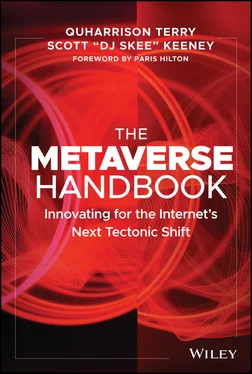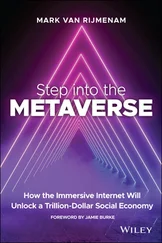Ultimately, 2D social networks were more effective than virtual worlds at onboarding droves of users and providing instant gratification. As a result, it's Facebook, not Second Life or There.com, that is the nearly trillion-dollar social networking company.
The year 2022 brought many of the same narratives we heard back in the early 2000s, except under the new moniker of “the Metaverse.” The commercial narrative hasn't changed much. Most brands view the Metaverse as a way to disguise an advertisement within the confines of a virtual experience, except that now the tech has completely changed.
Today, virtual worlds are largely being built on the back of the blockchain. Blockchain is a digital ledger that records transactions and information maintained and duplicated across a peer-to-peer network of computers, making it nearly impossible to record, edit, and hack false transactions. This allows creators to build digital scarcity into the social experience, turning everything from the game's land to the accessories our avatars equip into nonfungible tokens (NFTs). With blockchain as a new foundation of the Metaverse, the narrative has shifted to building a future that is user-owned, user-built, and ultimately for the user to reap the rewards. This is the rallying cry of the Metaverse today. It's an upgraded promise from the early Metaverses that were primarily social experiences with the occasional commercial opportunity.
Now, everyone is just $300 USD away from immersing themselves in a very impressive virtual reality experience. Consumer-ready virtual reality (VR) wasn't an option when Coca-Cola was building CC Metro. Furthermore, augmented reality (AR)—a real-world overlay of graphics and computer-generated information experienced through devices such as smartphones and smart glasses—was still the stuff of science fiction in the CC Metro world. The immersive technologies of VR and AR that are instrumental in the experience of the Metaverse are collectively known as extended reality (XR).
While current Metaverses like Decentraland are still accessed through the web browser, they will eventually collide with XR. The true vision of the Metaverse promises shared virtual experiences. And that is now in the realm of possibility for all builders, brands, and individuals.
In an interview with The Information, John Riccitiello, the CEO of Unity Technologies, predicts that VR/AR headsets will be as common as gaming consoles by 2030. With 250 million households owning gaming consoles worldwide, he is not predicting ubiquity on the level of the 4 billion smartphones worldwide. Rather, John sees XR as shared devices, like your game system or TV, which is a sentiment we largely agree with.
XR is an innovation in communication. Of course, gaming, entertainment, and commerce are great use cases for extended reality. And these experiences will make a significant impact on enticing people to use XR platforms. But it's the social experience that XR can facilitate that will make these devices so sticky for users. It makes you wonder how things would have been different for There.comif Meta's Oculus Quest 2 VR headset was around back then. But that's beside the point.
Ten years from now, XR and the Metaverse will be part of most of our lives. But how do we get to the point where nearly every household owns an XR headset and is accessing the Metaverse regularly? What Metaverse apps and experiences are onboarding people into the Metaverse today that will become the pillars of the Metaverse in 2032?
To answer these questions, we'll first look at the idea of personal Metaverses or Metaverse homes.
Your Own Personalized Metaverse
Talk of the Metaverse mostly revolves around the vision of a shared universe. But the shared Metaverse is actually made up of smaller units of personal Metaverses. The idea of your very own command center or home base in the Metaverse that you can control is what's most compelling about the Metaverse—much like how the Internet has evolved into a billion different personalized experiences where algorithms curate the content and services that reflect your views, interests, and needs.
RTFKT (pronounced “artifact”) is making strides in putting personal Metaverses into people's hands with the RTFKT Pods. The brand, which was acquired by Nike at the end of 2021, emerged on the NFT scene with its Metaverse sneakers but has since begun creating environments called RTFKT Spacepods. RTFKT excels at creating culturally significant digital objects. In other words, they know how to create hype around collectibles. These Pods are going to be collectors' home base for displaying their 3D NFTs and digital assets. While RTFKT's ultimate vision for Pods is kept secret, we can safely assume that these Pods will also double as social centers—places that Pod owners can invite friends to and host events in. In the near term, I'm doubtful that these pods will expand outside of the confines of a personal digital gallery. However, they're a part of the larger trend that will accelerate Metaverse adoption. That trend is the creation of customizable, personal Metaverse environments.
The next Zaha Hadid or Frank Lloyd Wright of the world won't ever architect a single building in the real world. Their focus will be on designing houses, offices, parks, museums, and other constructions in the Metaverse. And they'll have more than enough work to keep them occupied. Look no further than Krista Kim, the contemporary artist who made headlines for designing the Mars House and selling it as an NFT for 288 Ethereum (ETH) tokens, which were equivalent to $514,558 USD at the time. The Mars House was designed without the constraints of the laws of physics. The result is a meditative environment that is meant to inspire and create a calm virtual atmosphere.
Most of us will never have the pleasure of a corner office overlooking Central Park. But with personal Metaverses, we can all design and occupy our own Mars Houses that help us lead more productive and social lives.
Personal Metaverse platforms are where the magic will happen. Think of them as your home page to the Metaverse or your Metaverse home, if you will. All of the cool VR apps, games, productivity tools, meeting rooms, and upcoming events will be present in your Metaverse home. It's a space you can curate to reflect what you care about. And platforms that provide the means for people to create personal Metaverses will be a major part of making the Metaverse practical by 2032.
The Rise of Bots and Digital Humans
A big part of XR and the Metaverse's promise is a better means of communication and connection. But it won't always be a human on the other end of our communication. Rather, interacting with bots and digital humans will be our primary means of social interaction in the Metaverse. This isn't to paint a bleak picture of a future where we don't engage with other people. On the contrary, these digital humans will act as our own digital workforce. They will be able to carry out tasks on our behalf, provide services to us, and curate our experiences with other people in the Metaverse.
We've been moving toward this bot-assisted life for some time. A lot of people were introduced to bots by way of e-commerce iterations like AIO bot, KodaiAIO, NikeShoeBot, and GaneshBot. Generally called sneakerbots due to their widespread use in the rare sneaker market, these bots allow people to scoop up high-demand products the moment they are released to the public online. Many websites have “bot code” programmed into their website for quality assurance purposes. These internal bots run frequent, automated add-to-cart tests to ensure that their site is operating correctly. Sneakerbots exploit these lines of test code, allowing users to input their own billing and shipping information, as well as which products to target. The result is a hands-off, automated shopping experience for consumers to purchase high-demand products that are known to sell out in minutes, sometimes seconds. Culturally relevant brands—notably Yeezy, Nike/Air Jordan, and Supreme—that have bustling resale markets are routinely the target of these sneakerbots, which can be bought and used by anyone online. It's a widely shared view among companies like Nike and Supreme that sneakerbots have tainted these exclusive product markets, and they are always working to prevent their use. But that's a conversation for another book. Sneakerbots are an early example of having an AI-powered, digital companion that will do tasks on one's behalf.
Читать дальше












